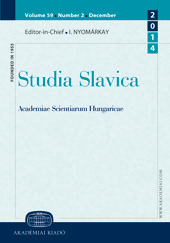Венгерско-славянские фразеологические параллели (диахронический аспект)
Hungarian-Slavic phraseological parallels (diachronic aspect)
Author(s): Valery Mikhailovich Mokienko, Tatyana Igorevna NikitinaSubject(s): Morphology, Lexis, Comparative Linguistics, Finno-Ugrian studies, Eastern Slavic Languages
Published by: Akadémiai Kiadó
Keywords: phraseology; paremiology; Slavic–Finno-Ugric language contacts; comparative phraseology; Hungarian–Russian phraseological parallels;
Summary/Abstract: The problem of Slavic–Finno-Ugric cultural and language contacts is one of the stable scientific dominants of Slavic studies. Though the lexical units remain the basis of etymological and ethnolinguistic reconstructions, phraseology has also recently become increasingly the object of research on Hungarian–Slavic and Slavic–Hungarian language contacts. A special place here is occupied by the analysis of the Finno-Ugric–Russian phraseological interaction. The paper offers a linguistic interpretation of 7 Hungarian–Russian phraseological parallels. The comparison with the Slavic and other Indo-European material helps to clarify their historical and etymological interpretation proposed by the famous Hungarian folklorist and paremiologist Gábor O. Nagy.
Journal: Studia Slavica Academiae Scientiarum Hungaricae
- Issue Year: 62/2017
- Issue No: 2
- Page Range: 247-275
- Page Count: 29
- Language: Russian
- Content File-PDF

